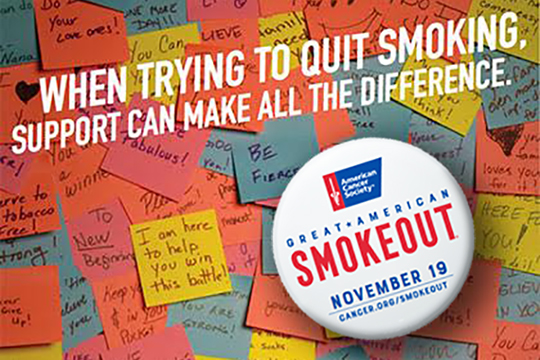News and Events
Highlands County Calls for Quit Attempts, Awareness During Great American Smokeout
November 19, 2020
The annual Great American Smokeout took place on November 19, 2020 and the Tobacco Free Partnership of Highlands County used this observance to encourage people to make a plan to quit smoking using the free tools and services available to Floridians.
Tracing its history back more than 40 years, the American Cancer Society’s Great American Smokeout marks a date when smokers are encouraged to use the date to either make a plan or to begin their quit journey (1).

Quitting smoking can add up to 10 years to life expectancy (2). The health benefits of quitting smoking include reducing the risk of heart attack and stroke, improving lung function and lowering the chances of getting an array of different cancers (3,4). The U.S. Centers for Disease Control and Prevention (CDC) adds that smoking may increase your risk of severe illness related to COVID-19 (5).
In addition to a healthier body, quitting smoking can lead to a healthier wallet. One year after quitting smoking, a former pack-a-day smoker can save over $2,200, based on today’s prices. Over five years, this adds up to a savings of over $11,000 (6).
Students Working Against Tobacco Youth set up Quitline information at Highlands County Middle Schools for all school staff and also set up a table during both lunches to encourage their peers currently using tobacco products to attempt to quit. The Tobacco Free Partnership of Highlands County is also sent out quit resources and educational materials to several local businesses and providing email resources to Florida Dept of Health and the Greater Sebring Chamber of Commerce
Employers across Highlands County can also use the Great American Smokeout as a time to encourage employees who smoke to consider quit plans. In addition to the health benefits, businesses also stand to gain when employees quit.
A recent report found that an employee who uses tobacco can cost his or her company thousands of dollars each year in health costs, distraction at the worksite, increased medical costs, higher insurance and other expenses (7). Employees who smoke are much more prone to absenteeism than those who don’t, with even former smokers who quit within the last three years costing employers an average of $1,327.53 less each year (8).
“We’ve known for years about the serious impact tobacco has on business, on lives, and on families,” said Amanda John “That’s why Tobacco Free Florida makes available for all Floridians services like Web Quit, Phone Quit and Group Quit and nicotine replacement therapy – all completely free and regardless of insurance. There are so many great reasons to quit – and the Great American Smokeout provides a perfect time to help someone begin their quit journey.”
Information on the history of the Great American Smokeout, national activities to support quitting and other materials can be found at https://www.cancer.org/healthy/stay-away-from-tobacco/great-american-smokeout.html. Tobacco Free Florida’s quit tips, tools and more are available by visiting www.tobaccofreeflorida.com or by calling 1-877-U-CAN-NOW.
____________________________________________________________________
References:
- "History of the Great American Smokeout." American Cancer Society. https://www.cancer.org/healthy/stay-away-from-tobacco/great-american-smokeout/history-of-the-great-american-smokeout.html. [accessed 10 August 2020.]
- U.S. Department of Health and Human Services. The Health Consequences of Smoking—50 Years of Progress: A Report of the Surgeon General. Atlanta: U.S. Department of Health and Human Services, Centers for Disease Control and Prevention, National Center for Chronic Disease Prevention and Health Promotion, Office on Smoking and Health, 2014. [accessed 10 August 2020.]
- U.S. Department of Health and Human Services (USDHHS). (2014). Let's Make the Next Generation Tobacco-Free: Your Guide to the 50th Anniversary Surgeon General's Report on Smoking and Health (Consumer Booklet). Atlanta, GA: U.S. Department of Health and Human Services, Centers for Disease Control and Prevention, National Center for Chronic Disease Prevention and Health Promotion, Office on Smoking and Health. [accessed 10 August 2020.]
- U.S. Department of Health and Human Services. A Report of the Surgeon General. How Tobacco Smoke Causes Disease: What It Means to You. Atlanta: U.S. Department of Health and Human Services, Centers for Disease Control and Prevention, National Center for Chronic Disease Prevention and Health Promotion, Office on Smoking and Health, 2010 [accessed 2020 August 10].
- “Coronavirus Disease 2019 (COVID-19): People with Certain Medical Conditions. U.S. Centers for Disease Control and Prevention. https://www.cdc.gov/coronavirus/2019-ncov/need-extra-precautions/people-with-medical-conditions.html#smoking. [accessed 2020 August 27.]
- “State Excise and Sales Taxes Per Pack of Cigarettes Total Amounts & State Rankings.” Campaign for Tobacco-Free Kids. https://www.tobaccofreekids.org/assets/factsheets/0202.pdf [accessed 2020 August 10.]
- Berman, Micah & Crane, Rob & Seiber, Eric & Munur, Mehmet. (2013). Estimating the cost of a smoking employee. Tobacco control. 23. 10.1136/tobaccocontrol-2012-050888. [accessed 2020 August 12.]
- Baker, Christine L. JD, MPH; Bruno, Marianna PharmD, MPH; Emir, Birol PhD; Li, Vicky W. MPH; Goren, Amir PhD Smoking Cessation Is Associated With Lower Indirect Costs, Journal of Occupational and Environmental Medicine: June 2018 - Volume 60 - Issue 6 - p 490-495
doi: 10.1097/JOM.0000000000001302 [accessed 2020 August 10.]




